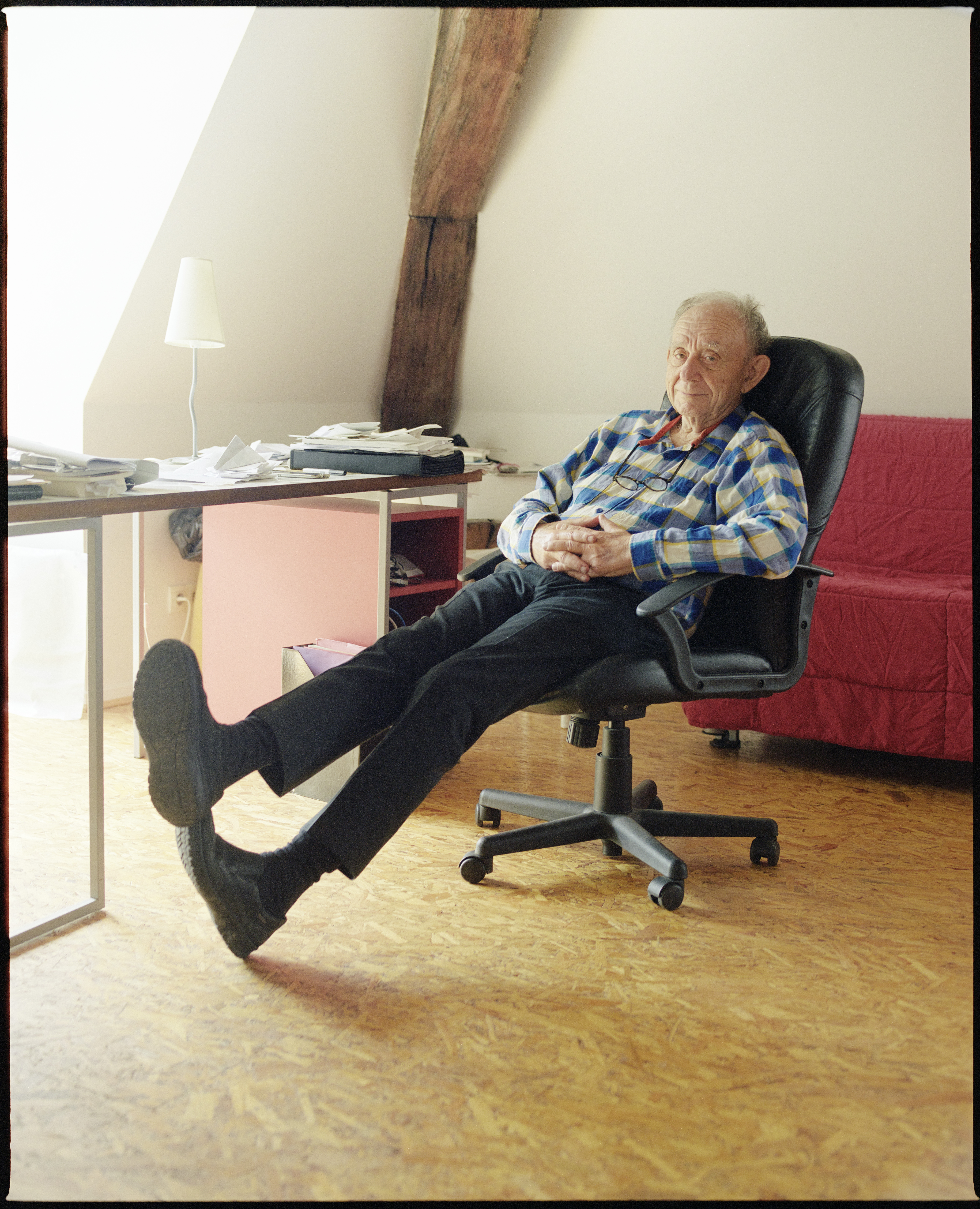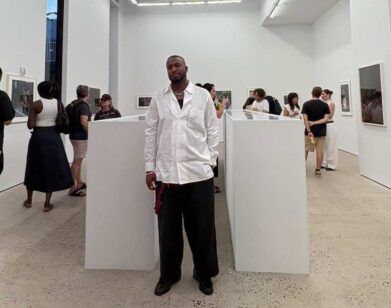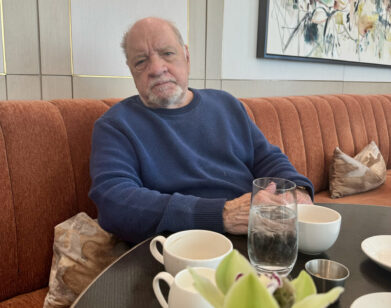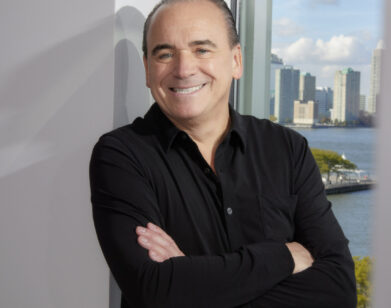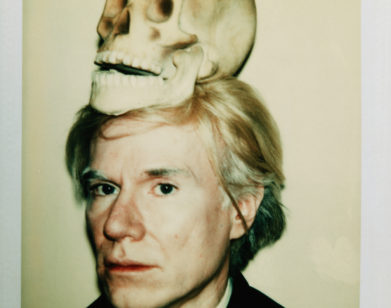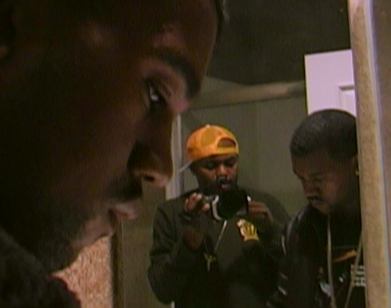Bon Appétit
“The Drama Is on the Plate”: Frederick Wiseman, in Conversation With Jean-Georges
In the popular imagination, thanks to shows like Hell’s Kitchen and Top Chef and The Bear, the kitchen is a site of cacophony and men with short fuses, a place where it’s generally accepted that sanity and decorum are the cost of excellence. (Think of the viral meme showing Jeremy Allen White, playing Chef “Carmy” Berzatto in that latter series, holding a ladle, his faced fixed in a hysterical squawk). Menus-Plaisirs — Les Troisgros, the new documentary from the masterful and prolific Frederick Wiseman, offers something of an antidotes to these tropes. Wiseman’s 44th documentary follows the inner workings at Le Bois Sans Feuilles, a family-owned restaurant in Ouches, a pastoral region of Central France, that has boasted three Michelin stars since 1968.
Here, excellence, sustained over generations, is the product of teamwork, hard-nosed diligence, relentless curiosity, and an almost pious respect for the customer experience and the possibilities of fine-dining. There are early morning trips to the nearby farmer’s market, unhurried recitations of various patrons’ dietary restrictions (logged rigorously by the staff at Le Bois Sans Feuilles), and patient, captivating scenes of crayfish coming to a boil; a moderately tense conversation about the efficacy of almond purée is about as melodramatic as it gets. So, before the film’s release, Wiseman got together Jean-Georges Vongerichten, who knows something about Michelin Stars, to talk about his first filmmaking foray into the kitchen.
———
JEAN-GEORGES VONGERICHTEN: I’m sorry I moved the interview a little bit. I had a crazy last couple of weeks.
FREDERICK WISEMAN: No crazier than mine. I was in the hospital and I’ve been traveling.
VONGERICHTEN: Oh, sorry to hear that. Are you all good?
WISEMAN: I’m living under the adage, “Old age is not for sissies.”
VONGERICHTEN: I’m right behind you.
WISEMAN: No, no. You’re an adolescent. By the way, do you know the Troisgros family?
VONGERICHTEN: So, I’m in the business for 50 years now and I’m from Alsace, from Strasbourg, and actually, when I was a young apprentice at 16, I had dinner at Troisgros when the two brothers were still alive. I was working at Auberge de l’Ill and Paul was good friends, of course, with the Bocuse and Chappell and all the gang at the time. So, as a young cook. And they sent me there to have a beautiful dinner with another chef and it was a life-changer, of course, in 1973. I remember every single dish. I mean, it was an incredible meal in the old Troisgros house.
WISEMAN: That’s a fantastic memory. I don’t have a memory quite like that. In the summer of 2020, I stayed at a friend’s house in Burgundy and I wanted to thank my friends for putting me up during the COVID, so I looked in the Michelin guide for a three-star restaurant nearby and I found Troisgros, which I’d never visited or eaten in before. And we went and had lunch. And after lunch, César, Michel’s son, came around and talked to the people in the dining room. And without planning to do it, I sort of blurted out, “I make documentary movies, would you ever consider having a movie made at this restaurant?” And he said, “Let me talk to my father.” So he came back about a half-an-hour later and said, “Why not?” I discovered a year later, when I’d finished the film, that Michel was not there that day. What he did was look me up in Wikipedia, something I haven’t even done myself, and he found good references. It was sheer chance that I got to make the movie.
VONGERICHTEN: Amazing. Amazing. I mean, they go back four generations now. I’m only two generations in restaurants.
WISEMAN: It’s a real restaurant aristocracy.
VONGERICHTEN: I always had this relation with them because I know the two grandfathers and the two sons. I see them once in a while at events
WISEMAN: They were extremely nice to me. I was filming there for seven weeks and we ate with the chefs every day. So I’ve had 70 meals at Troisgros.
VONGERICHTEN: Wow, that’s amazing. 70 meals is impressive.
WISEMAN: I am no expert on cuisine, but it was a marvelous experience for me. They were so friendly and so helpful and kind, and the experience was completely contrary to the cliche of what you see in so many bad cooking movies on cable television. Nobody yelled at anybody else. The kitchen was extremely well-organized. Have you eaten in the new restaurant in Ouches?
VONGERICHTEN: I see a lot of it on Instagram, a lot of stories and pictures, but I haven’t had the privilege to go there yet. But I will. And I think that family is the definition of hospitality. Besides being great chefs, they’re really great restaurateurs and they treat everybody like family. I remember when I was an apprentice as well, I was living above the restaurant with the family. They treat you like you’re part of them.
WISEMAN: They were kind, friendly, very intelligent people. I liked them a lot. I’m going to Roanne next Monday to show the film to all the people that worked in the restaurant and all the friendly staff as a way of thanking them for participating.
VONGERICHTEN: That’s an amazing project. So you were there for a long time to film?
WISEMAN: Every day for seven weeks. I shot for 35 days and I accumulated about 140 hours of film.
VONGERICHTEN: Are they still doing some of the classic foods or not?
WISEMAN: Well, you can get the salmon à lousse à la carte, but the menu is frequently changing because they’re constantly experimenting with new forms. For me, it was the first time I had spent any time in the kitchen of any kind of restaurant except the kitchen in my own house. About 40% of the film takes place in the kitchen and the rest of the film, I went to the market with them, I went to the place where a lot of the cheese that they buy is manufactured, I went to vineyards. I tried to establish the context of the restaurant, and not only how the meals were prepared, but where the food was purchased. To create this kind of food, three-Michelin star food, it’s all about the product. It’s all about the sourcing. They have their own garden, which I think several of the major French restaurants have their own garden. That’s more difficult in New York.
VONGERICHTEN: Absolutely. I mean, for the Tin Building, we’re using 90% of the produce from farmers from a hundred miles around New York. I mean, we don’t have the gardens because we live in a vertical city, but when I arrived in New York in ’86, there were just a few apples and potatoes in the market. Now, we have five different colored carrots, five different colored beets. I was in Strasbourg last week because my mother turned 90 years old, and the markets are very different there. I’m excited about how far along we’ve come in New York. If you take a place like La Maison Troisgros, they’re not only keeping all those farmers alive by buying the product, but they’re creating jobs for the area, for the communities. It’s not just a restaurant, it’s a whole community they’re creating around the restaurant.
WISEMAN: I was very interested in their cave. I was amazed to learn they have 31,000 bottles of wine.
VONGERICHTEN: There’s no restaurant that has room for that in New York. You need to build a building just for the cave. That must be an amazing collection.
WISEMAN: Some of the wine is quite old and very expensive. The sommelier had a vast amount of knowledge about wine and the vineyards all over France. I had no experience with that before.
VONGERICHTEN: I feel like those guys live and breathe the wine cellar. Do you know how many people work there in the kitchen? Did you get the numbers?
WISEMAN: I think there are 15 or 16 people working in the kitchen. They have it organized, obviously, by stations. And there’s not much conversation. I found that interesting. Everybody knows what their job is and directions are given by a wink or a movement of the hand. There’s an economy of words and there’s no long conversations, no yelling and screaming. It was completely contrary to the cliches that you see on cable television about restaurants.
VONGERICHTEN: Absolutely. Even when I did my apprenticeship at Auberge de l’Ill for three years, my mentor, the chef, Paul Haeberlin, I never heard him raise his voice once. There’s no reason to. They teach you how to cook and then you follow the recipes. The cooking is intense enough. You don’t need anybody to be yelling at you.
WISEMAN: Yeah. And all the people in the kitchen work very, very long hours. Some of them are in the market at seven in the morning and then they work through three o’clock in the afternoon and come back at five o’clock and do the evening meal.
VONGERICHTEN: Welcome to the restaurant life.
WISEMAN: I should think it’s hard to have a personal life.
VONGERICHTEN: It’s amazing to have somebody like you to capture it because it’s the real life of a family and it’s a constant push for perfection, the pressure to keep the three Michelin stars and be better today than yesterday and even better tomorrow.
WISEMAN: I was fascinated with the demand they put on themselves to make the place look beautiful. Everything is very delicate and beautifully arranged on the plate. It’s not just the taste of the food, but it’s the look, and a lot of thought and intelligence goes into that.
VONGERICHTEN: You know what, I wish every single food critic would spend some time like you did in the kitchen to really understand what it takes to produce this kind of quality and excellence. They would be kinder to restaurants.
WISEMAN: Michel Sazar would be at the last counter with pincers, and if something was an eighth of an inch out of position on the plate, they would move it so that the form and color of the various elements of the dish would look very pleasing. And I had no idea. I took it for granted.
VONGERICHTEN: How big was your crew over there to film?
WISEMAN: Me and three others. When we were shooting in the kitchen, it was a problem. We had to be very conscious of staying out of the way. We were constantly dodging the cooks as they moved around because I certainly didn’t want to alienate them or interfere with their preparation of the meals. In addition to trying to figure out what to shoot, you had to move as fast as they moved to stay out of their way.
VONGERICHTEN: Absolutely. So they have an à la carte menu and a tasting menu, I presume? I haven’t been there for a long time.
WISEMAN: They have an à la carte menu and they have a tasting menu and they have a pairing menu. There’s a pairing menu with 10 dishes and 10 different wines.
VONGERICHTEN: I need to go back.
WISEMAN: I’ll tell them. I’m going to see them in Roanne next Monday.
VONGERICHTEN: Send my regards and really tell them I’m coming very soon.
WISEMAN: One of the things that impressed me about the head waiter was how well he knew the customers. When he briefed the waiters for lunch or dinner, he knew what foods they ate, particularly the old-time customers. They knew what the food allergies were and they were extremely attentive to the particular demands of the clients. I’m sure you do the same thing.
VONGERICHTEN: Yeah, that’s service at the highest point. I mean, it’s not easy to do unless you put it in a computer. It’s a little easier now with the reservation system that we have, it’s easier to put a profile of a guest and put in there what they like, they dislike, the allergies. But it’s remarkable that they keep that level of service.
WISEMAN: I didn’t realize how demanding an occupation it was until I spent seven weeks there.
VONGERICHTEN: When I started in Alsace in a three-star Michelin, I was an apprentice in ’73. Then three years after I moved to the south of France, I went to L’Oasis, another three-star. Then I went to Louis Outhier, another three-star, then I went to Paul Bocuse in Lyon. Then I went to another three-star in Munich. You constantly have to move around and see the next technique, preparation, combination of food. Even today I use travel to get inspired. I was in Asia last month, Tokyo, Kyoto, Shanghai, and I came back with new ideas, new flavors, new spices.
WISEMAN: Have you been influenced by Japanese cuisine? Because Michel and César have been very influenced by Japanese cuisine.
VONGERICHTEN: Yeah, I was, mostly in Southeast Asia. In 1980, I went to the Oriental Hotel in Bangkok, where I spent two years, one year in Singapore, one year in Hong Kong, six months in Japan. Asia was always a part of my flavor palette. Coming from Alsace, we had dry spices that we used for cookies and things and I never knew where cardamon or ginger or star anise was. It was always a dry powder. But then you arrive in Southeast Asia and you have fresh lemongrass, fresh ginger, fresh galangal, all the beautiful chilies. My food is really a mix of French techniques, New York ingredients from the local farmer or the fish from the Northeast Atlantic, and then my palette of flavor seasoning, herb spices, all from Asia. Or most of it. In French cuisine, the spices we use are all from other countries, other areas. I feel like even the ancient French cuisine was all inspired by traveling.
WISEMAN: The international nature of the cuisine is remarkable. To have all those experiences and adapt them.
VONGERICHTEN: Food is very personal. To grow up like Michel and César, with their parents and business, it’s in their DNA, it’s part of their life.
WISEMAN: There was a about 10 or 11-year-old grandson of Michel’s who would come into the kitchen from time to time and work, so you saw even the fifth generation preparing.
VONGERICHTEN: Stunning.
WISEMAN: Do you have children who are working with you?
VONGERICHTEN: Yeah, my son is working with me at one of the restaurants, Perry Street. He has his own restaurant in Nolita. We’re not working side by side, though we did in the past, but now he flies on his own. He has four or five restaurants on his own, but we still work together in a field.
WISEMAN: And I assume you’re constantly experimenting and trying out new combinations. I was impressed how almost every day César and Michel, in consultation with some of the other senior chefs there, would be trying out new recipes for desserts or main courses. It’s constantly evolving.
VONGERICHTEN: That’s what it is. When you have an institution like the Troisgros, you have people who are coming for the classics, and then some people are coming for the new creative cuisine. We have to keep evolving every recipe all the time.
WISEMAN: Well, it keeps you on your toes.
VONGERICHTEN: Today, in 2023, people are more educated about great food around the world. Today, every city has a great market. Every city has the local talents.
WISEMAN: What do you mean by a great market?
VONGERICHTEN: When I arrived in New York in ’86, the market was very limited. There was not much farmer produce. Everything was imported from California or imported from Europe. Today, the Union Square Market is one of the greatest markets in the world. Every city all over the world now has great markets because the local chefs are demanding better products. People are used to traceability. Yes, it’s an organic carrot, but you want to know where it grows from, where it comes from, how it grows. You can’t just put anything on a plate today.
WISEMAN: But that also adds to your burden as a chef because you have to expand your area of knowledge.
VONGERICHTEN: Absolutely.
WISEMAN: That’s one of the things that makes it interesting.
VONGERICHTEN: You never stop. It’s a nonstop challenge every day.
WISEMAN: It’s fascinating. I mean, I felt I was watching artists at work, because it’s an art form. And it’s an art form that requires a vast amount of knowledge and also an enormous visual sense, compositional sense.
VONGERICHTEN: It’s not only the flavors. It has to look good and taste good. And there’s a balance to every single dish. It’s very important to make sure the first bite is as exciting as the last bite.
WISEMAN: It was a privilege.
VONGERICHTEN: So, when is the film coming out?
WISEMAN: It opens in New York tomorrow.
VONGERICHTEN: I think it’s going to be exciting to show a real documentary movie about the way a high-end restaurant runs. There’s no drama. It’s just about pleasing the customer, getting the best ingredients.
WISEMAN: Yeah, the drama is in the hard work.
VONGERICHTEN: Exactly. The drama’s on the plate.

